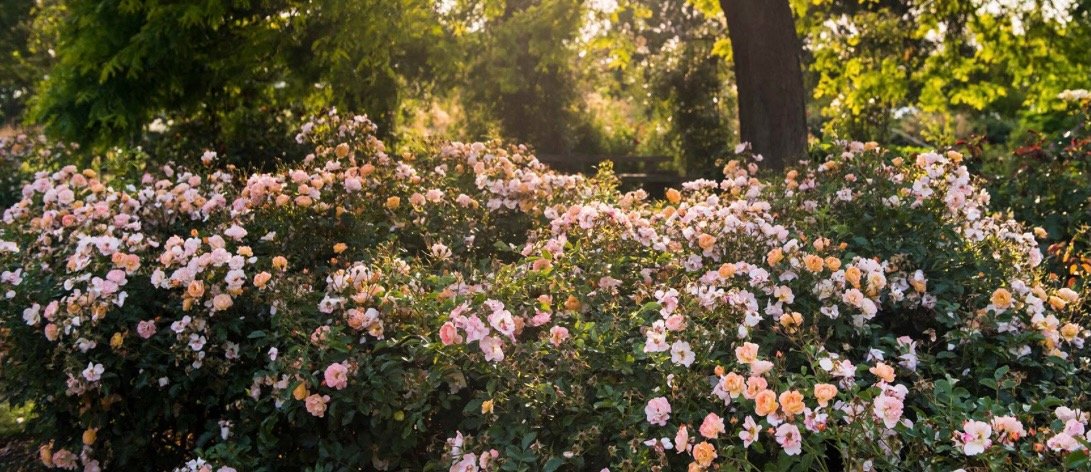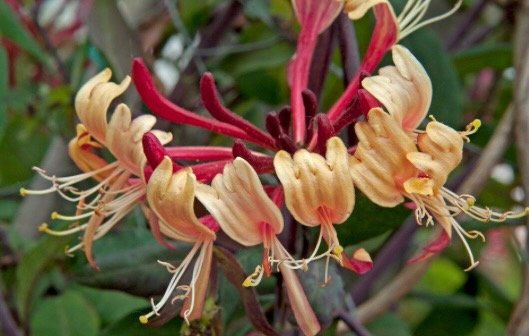June 2023 Musings-Right Plant-Right Place
illustration by Jane: An environmentally resilient garden
I’ve recently read the findings of a survey commissioned by the Royal Horticultural Society on how to boost the potential of our gardens to combat the environmental challenges that we are all beginning to face. I know we hear a lot about ‘environmental challenges’ but we’re already experiencing some of them, with hotter summers and wetter winters and springs. I’m keen to find some practical solutions to help make our lives a little more comfortable and our gardens happier places to be in.
The published research results indicate that the way to make gardens more environmentally resilient is to populate them with plants which are best suited for the location, complement each other (e.g.in terms of nutrient and water use) and increase the number of layers of planting on whatever ground is available. This is joy to my ears as it’s something we can all do and I’ve been promoting and practicing this style of gardening for years!
illustration by Hannah Longmuir
In a nutshell:
Grow as many plants as possible. Not just by covering as much of your garden as possible with planting, but also increase the range of plants you grow.
Plant perennials (including herbaceous, trees, shrubs, and hedges), as these will remain in the ground for many years, providing environmental benefits throughout their long lives.
Grow as big as you can. Not every garden can accommodate a large tree, but trees, hedges and shrubs will provide the most benefits, purely by virtue of their size. Bigger plants will also often provide multiple benefits at the same time. If you rent, this might not be possible, but if landlords are made aware of the benefits, they may be more receptive. Alternatively, consider re-using containers to make a mobile garden that you can take along to your next home.
Choose the right plants to help you. For example: If summer heatwaves make you uncomfortable, plant to shade and cool the air, this could include trees and climbers on the walls of your house. For traffic and noise pollution, a hedge in the front garden between you and the road can help.
Take time to enjoy your garden. It’s something that we all learnt in lockdowns, and the rewards of being outside ‘in the green’ can continue for life. If you can make time – gardening is an excellent way of helping our wellbeing, part of being kind to ourselves because we’re worth it! Perhaps add some evening scented plants to your garden to enjoy after a days work, here’s a small selection:
Please contact me to arrange your own personal garden plant lists and care guides 07811 367320
Right plant, right place. It’s an old garden adage, and one of my favourites. It means growing the plants that will thrive in the natural conditions of your garden. If you have a naturally dry garden in summer, drought- tolerant species are the perfect choice. You will have more success, and the plants won’t need so many environmentally costly inputs such as water and fertilisers.
Don’t underestimate the value of collecting rain in water butts, home composting and growing your own food. Sustainable practices such as these all help reduce our negative impact on the environment and make you feel good.
Improve your gardening skills and knowledge. If you haven’t already, consider joining your local gardening club, they’re a friendly and supportive bunch! There’s also lots of help on the internet and if you would like some One to One tuition and advice, call me on 078111 367320 and book in some Flower Hours: a friendly home visit full of tailored advice, tuition and practical assistance just for you and your garden, I’m here to help!
The Potting Shed
Things to do in June:
The longest day of the year on the 21st will soon be upon us. the extra light and warmth at this time of the year encourages a great big growth spurt but unfortunately that also means the weeds!
1) Keep on top of those pesky weeds by hoeing regularly in dry conditions but please consider leaving a wild corner of them alone to help encourage and feed our wildlife.
2) At last, it’s time to plant out your summer bedding, now that the late frost risk has gone, your tender plants and herbs can enjoy the great outdoors.
3) Pinch out the side shoots of tomatoes. Every time you water, check the plant for any side shoots sprouting just above each leaf, from the joint between the leaf and the stem and remove the little shoots to promote a better crop.
4) Harvest lettuce, radishes, other salads, and early potatoes
5) Mow the lawn but please consider leaving some areas uncut for wildlife.
6) Stake tall or floppy plants.
7) Clip evergreen hedges such as privet (Ligustrum), Box (Buxus) and Lonicera nitida if needed.
8) Prune many spring flowering shrubs such as Ribes, Forsythia, Mock Orange, Weigela and Kerria- Shrubs that flower over winter and early spring will benefit from damaged or dead shoots being removed. If there are lots of stems, cut back a third to ground level to keep the plant open and avoid congestion, lastly, take out any weak or spindly shoots so that the plant can concentrate its energy on the strongest new shoots that will bear the best flowers.
9) Shade green houses to keep them cool and prevent scorch.
10) Fill your border gaps: Its not to late to sow a few fast growing, late flowering hardy annual seeds such as Calendula, Godetia and Clarkia and perennials such as hollyhock, delphiniums, and lupins. Plan for next spring and sow wallflowers, pansies and daisies between May and July.
Carpet roses
Plant Spotlight:
Who knew! Everyone has a birth flower depending on the month they were born. Roses and Honeysuckle are the two flowers most associated with June.
“Would love appoint some flower to reign
in matchless beauty on the plain,
the rose (mankind will all agree),
the rose the queen of flowers should be”
Sappho.
Roses:
There are some 300 species of wild rose and thousands of hybrids in every colour under the sun – except for black. No flower is more embedded in our collective conscious. It is mentioned in a Sumerian tablet dating from around 2860 BC. In the sixth century BC, Confucius reported that the imperial Chinese library had many books on roses, and the remains of rose wreaths have been found in ancient Egyptian tombs.
You could write a book about the symbolism of the rose. In brief, It’s the national flower of England and of the United States, often identified with the Virgin Mary, and a symbol of love in Islam and Sufism. Choose Red roses for love, yellow for joy and friendship, white for purity and sympathy or pink for gratitude and admiration.
Honeysuckle:
Because most honeysuckles are clinging climbers, they have been used to signify love that binds two people together – and because of their nectar, they’re emblematic of sweetness. honeysuckle also represent happiness and positive energy.
There are many species and cultivars but the evening scent of our native English Honeysuckle Lonicera periclymenum is still one of my favourites. It’s indicative of lovely warm summer evenings and I like to plant it near the house and outdoor seating areas to enjoy its nearly overpowering fragrance.
Honeysuckle puts on its scented show at night not just for our enjoyment but to attract pollinating moths such as the hummingbird and elephant hawkmoth. This also accounts for its pale colour, which shows up better in darkness, and its long, trumpet-shaped flowers, formed to perfectly guide the moth’s proboscis to its nectar.
Honeysuckle
Happy Gardening!






